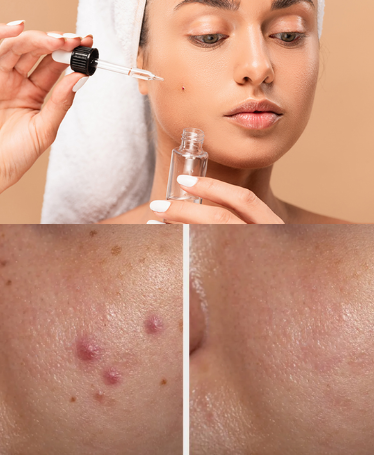
Acne is one of those stubborn skin issues that feels like it has a mind of its own. You finally calm a breakout, only to be left with scars, redness, or dark spots that linger like unwanted guests. While countless products promise a quick fix, few ingredients live up to the hype. One standout that’s earned its place in modern skincare is Niacinamide.
This powerhouse form of Vitamin B3 has gained recognition not just for its soothing effects, but also for its ability to target acne at multiple stages—without being harsh. Let’s dive into why Niacinamide deserves a spot in your skincare routine if you’re serious about tackling acne.
How Acne Develops
Before we understand how Niacinamide helps, it’s important to know what we’re up against. Acne isn’t caused by just one thing—it’s the result of a perfect storm happening beneath the surface:
- Excess oil production: Overactive sebaceous glands flood your pores with sebum.
- Clogged pores: Dead skin cells and debris trap oil inside, leading to blockages.
- Inflammation: Redness and swelling flare up as your body reacts.
- Bacterial growth: P. acnes bacteria thrive in clogged pores, worsening the cycle.
Because acne is multi-layered, it requires an ingredient that can multitask. That’s where Niacinamide steps in.
What Exactly Is Niacinamide?
Niacinamide, also known as nicotinamide, is a water-soluble form of Vitamin B3. It’s found in countless serums, moisturizers, and toners because it plays well with other ingredients and works on nearly all skin types.
Unlike harsher acne treatments that strip or irritate the skin, Niacinamide is gentle, calming, and effective—making it especially helpful for sensitive or acne-prone skin.
Key Benefits of Niacinamide for Acne-Prone Skin
Niacinamide’s strength lies in its versatility. Think of it as the reliable friend who always has your back—whether you’re dealing with active breakouts, lingering scars, or just overall skin imbalance.
1. Calms Inflammation
Acne is an inflammatory condition, which explains the redness and soreness around breakouts. Niacinamide reduces inflammation at the cellular level, helping calm irritation and minimize flare-ups.
2. Controls Sebum Production
Too much oil equals more breakouts. Studies show that just a 2% Niacinamide formula can significantly reduce excess oil within weeks. By balancing sebum, it prevents clogged pores and new pimples.
3. Strengthens the Skin Barrier
A weak skin barrier is like an unlocked door for bacteria and irritants. Niacinamide boosts ceramide production, fortifying the barrier so skin becomes less reactive and better protected.
Video : You’re Probably Using Niacinamide Wrong! How to Use, Layer, & Combine Niacinamide for Real Results
4. Reduces Clogged Pores
By regulating how skin cells shed, Niacinamide lowers the risk of dead cells clogging pores—cutting down on blackheads and whiteheads.
5. Fights Pigmentation
Those dark marks left after acne? Niacinamide prevents melanin from over-accumulating, which helps fade post-inflammatory hyperpigmentation.
6. Improves Texture and Scars
By promoting collagen production, Niacinamide helps smooth rough patches and soften the appearance of shallow scars.
What Studies Say About Niacinamide and Acne
Niacinamide’s popularity isn’t just marketing—it’s supported by clinical research:
- A study published in the International Journal of Dermatology found that a 4% Niacinamide gel worked just as well as a 1% clindamycin gel for acne, with the added benefit of improving skin barrier health.
- Research in the Journal of Cosmetic Dermatology showed Niacinamide reduces pore size and oil production, two key acne triggers.
- A 12-week trial demonstrated that even a 2% Niacinamide solution could cut down on acne lesions, inflammation, and excess shine.
Science confirms what skincare lovers already know: Niacinamide is effective, safe, and reliable.
How to Add Niacinamide Into Your Routine
Ready to try it out? Here’s a simple guide to make Niacinamide work for you:
- Cleanse Gently: Use a pH-balanced cleanser to prep your skin.
- Apply Niacinamide Serum: Go for 2%–5% if you’re new, or up to 10% if your skin tolerates actives well.
- Moisturize: Choose a lightweight, non-comedogenic cream to lock in hydration.
- Sunscreen Always: Niacinamide isn’t photosensitizing, but UV exposure worsens scars—so SPF is a must.
- Pair Wisely: Niacinamide works well with retinol, salicylic acid, and hyaluronic acid, making it easy to combine in a routine.
Extra Perks Beyond Acne
Niacinamide isn’t just for breakouts—it’s an all-around skin booster. Regular use can:
- Improve skin elasticity and firmness
- Protect against environmental stressors like UV rays and pollution
- Reduce blotchiness and redness, even in rosacea-prone skin
It’s like getting multiple serums in one.
Possible Side Effects
For most people, Niacinamide is gentle and irritation-free. But if you jump straight into high concentrations, you might notice:
- Temporary redness
- Mild itching
- Dryness (usually from the formula, not the Niacinamide itself)
To avoid issues, start low, patch test, and let your skin adjust gradually.
Video : Niacinamide | Avoid these mistakes| Dermatologist
Conclusion
Niacinamide isn’t just another trendy ingredient—it’s a proven solution that tackles acne from multiple angles. By calming inflammation, regulating oil, strengthening the barrier, and fading scars, it delivers visible improvements without the harsh side effects of stronger treatments.
If you’ve been searching for a skincare ally that’s gentle yet powerful, Niacinamide deserves a permanent spot in your lineup. With consistent use, you’ll notice clearer, smoother, and healthier-looking skin—proof that sometimes, the simplest ingredients are the most effective.


